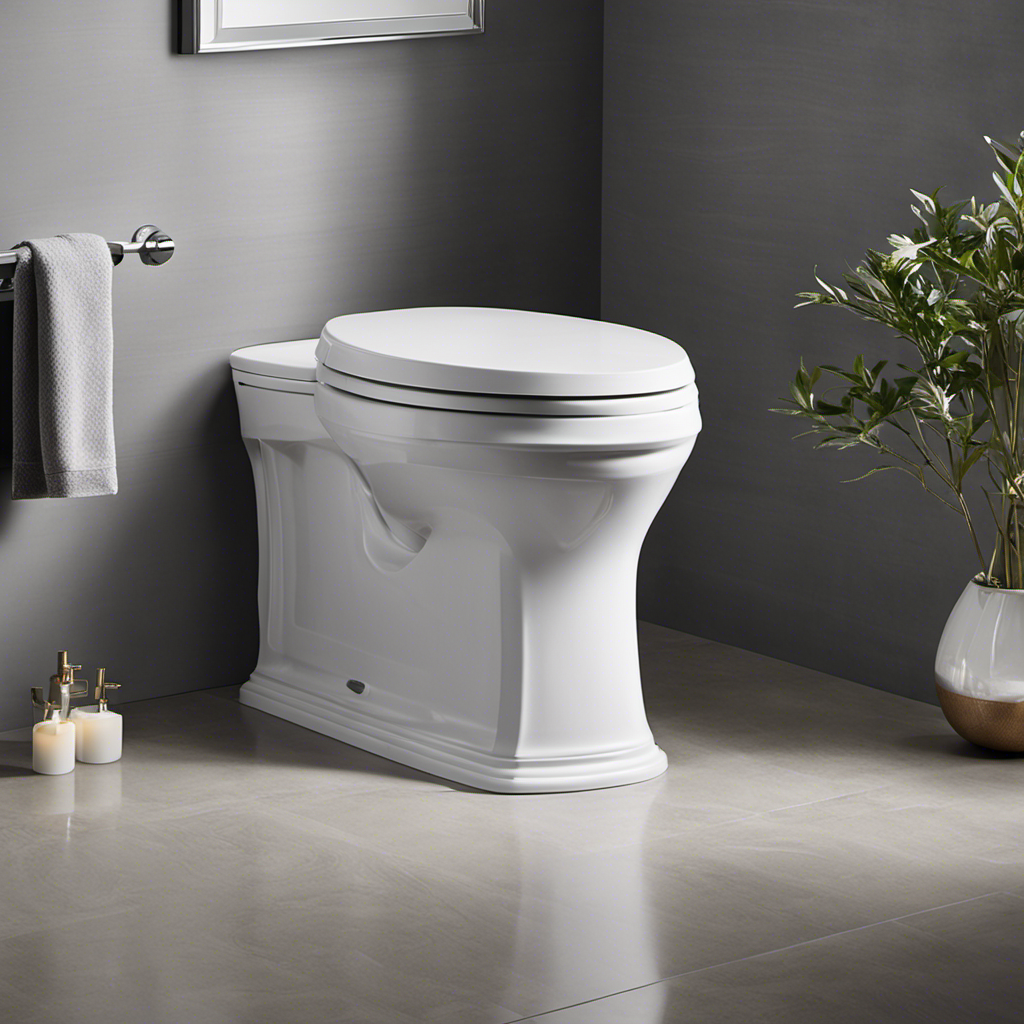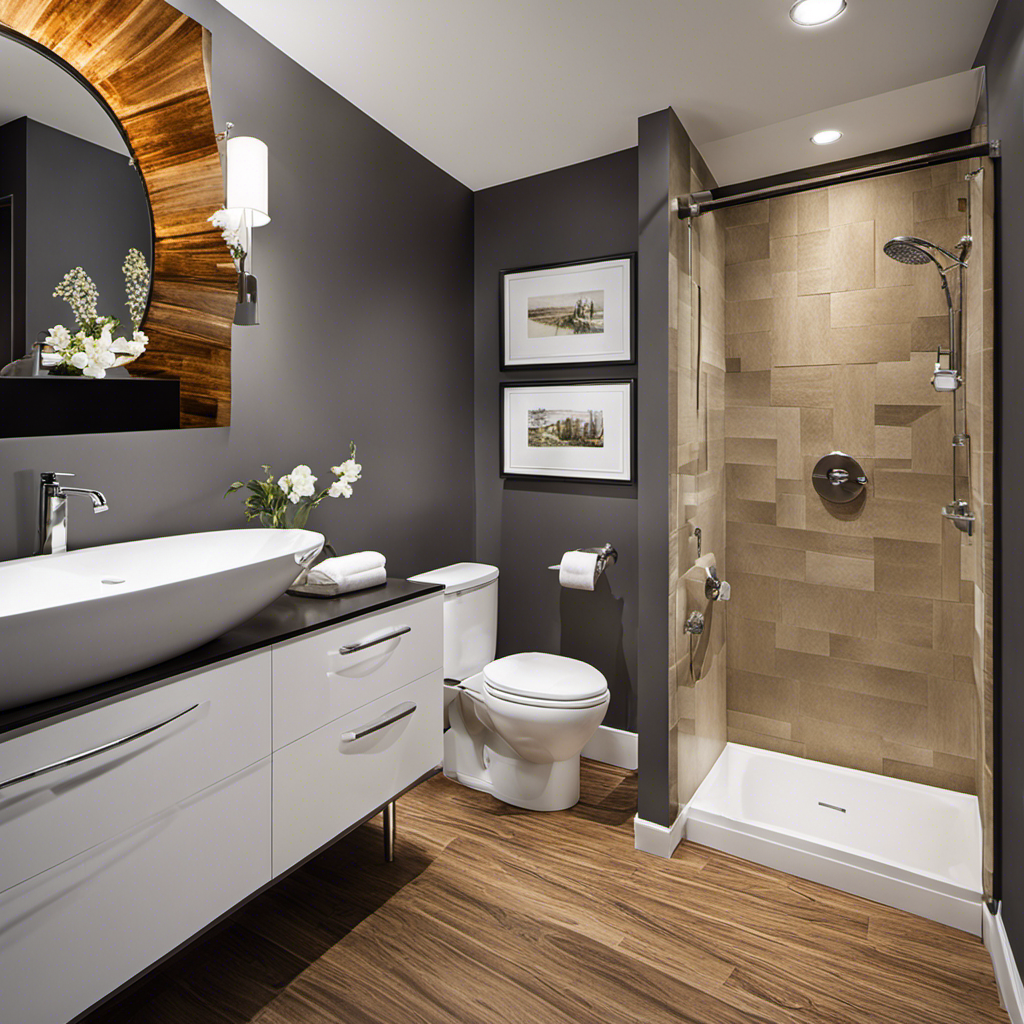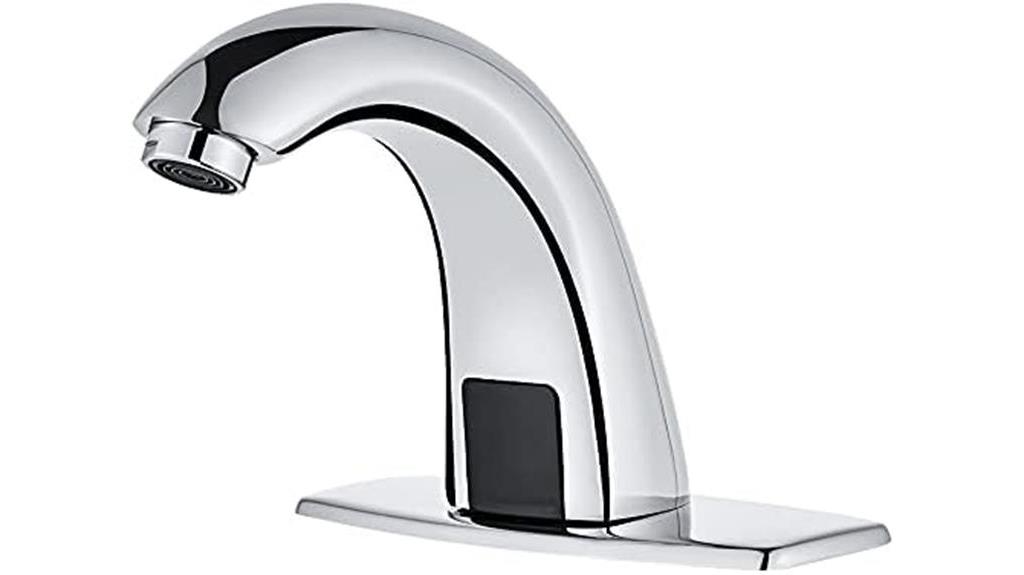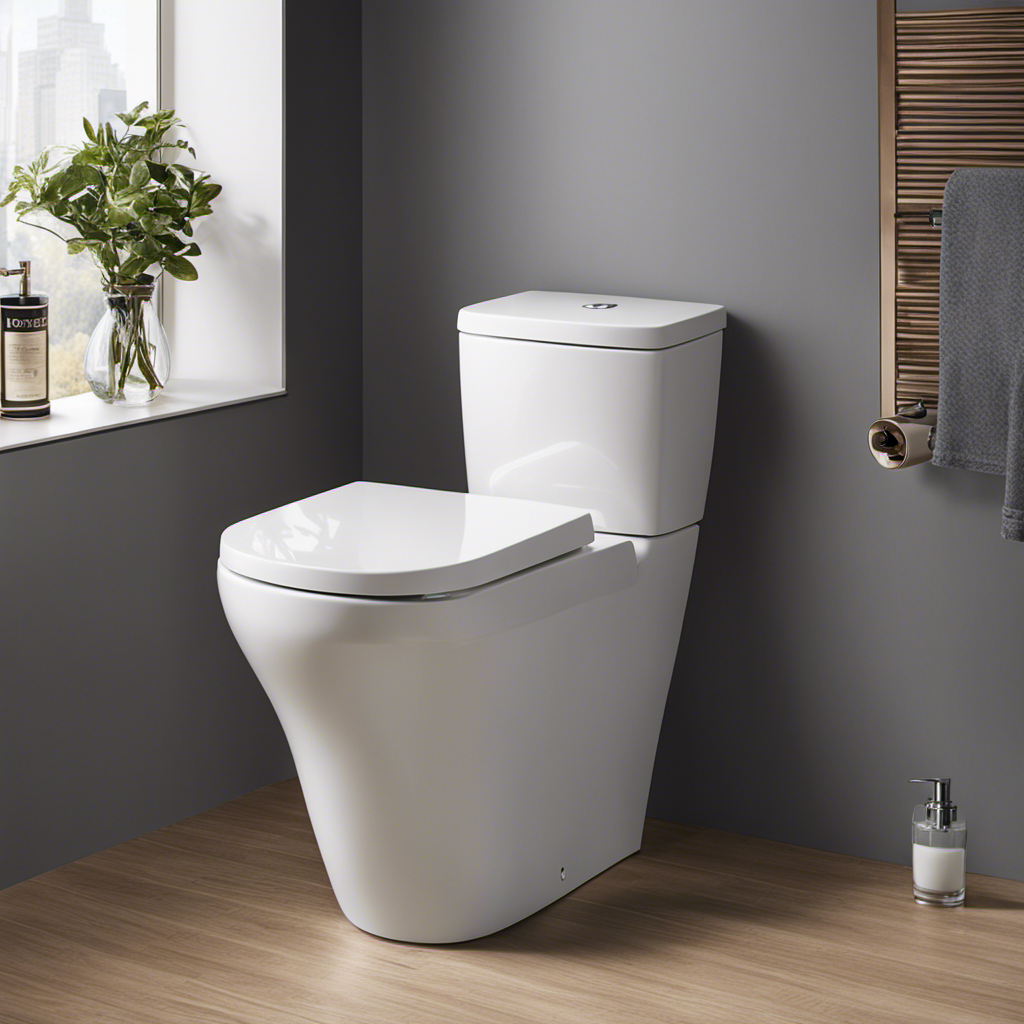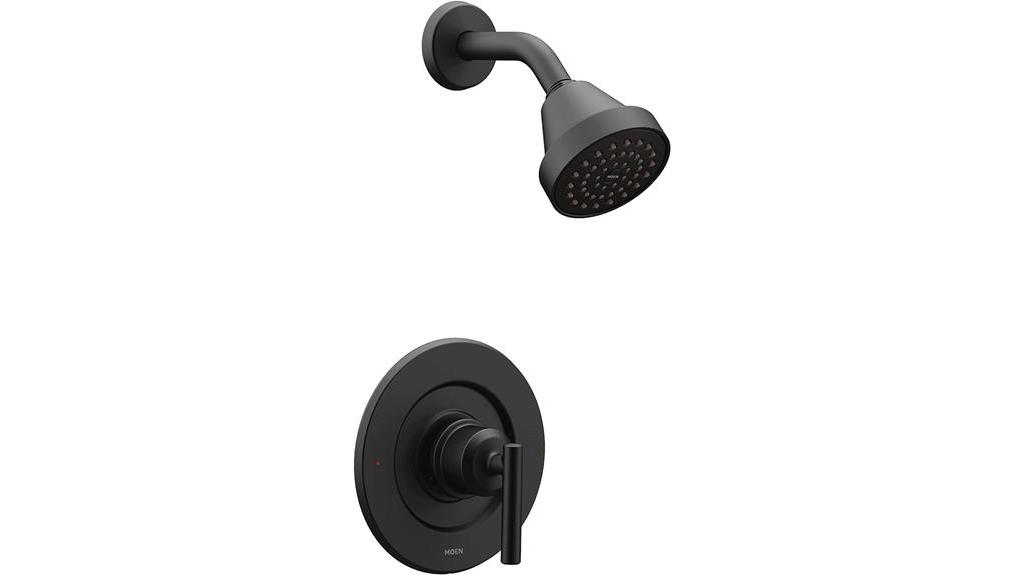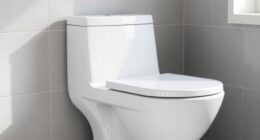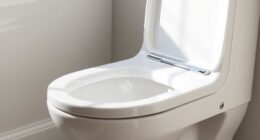As a homeowner, I know the importance of finding a toilet that combines style and functionality. That’s why I was intrigued to discover the Kohler Archer K-3551, a toilet that boasts both elegance and performance.
With its sleek design, vertical handle lever, and sharp beveled edges, the Archer toilet offers a contemporary look that will elevate any bathroom. But it’s not just about looks – this toilet features Comfort Height seating, AquaPiston Technology for a powerful flush, and WaterSense certification for water efficiency.
In this review, I’ll dive into the details of the Kohler Archer toilet to help you determine if it’s the right choice for your home.
Key Takeaways
- Kohler Archer has a minimal design with a vertical handle lever and beveled front edges, giving it an elegant look.
- The toilet is WaterSense certified and uses Kohler’s AquaPiston Technology for a powerful and efficient flush, using only 1.28 gallons of water per flush.
- The Comfort Height seating over 17 inches makes it suitable for a wide range of users, and the elongated bowl provides extra comfort for adults.
- The Kohler Archer toilet is easy to install with the two-piece model and DryLock™ System installation system, making it suitable for DIY installation even for those with limited experience.
Design and Aesthetics
I really like the elegant design of the Kohler Archer toilet. Its beveled front edges and minimal tank design give it a sleek and modern look. The ergonomic features and user comfort are top-notch. The Comfort Height seating, with a height over 17 inches, makes it suitable for a wide range of users. The elongated bowl, roughly 2 inches longer than a standard toilet, provides added comfort for adults. The beveled edge base adds to its aesthetic appeal.
What’s more, the Kohler Archer toilet offers versatility in color and material options. You can choose the perfect fit for your bathroom decor. With various color choices and materials available, you can customize it to your liking. The Kohler Archer toilet not only looks great but also provides exceptional comfort and style.
Flush Performance and Efficiency
The AquaPiston flushing system in the Kohler Archer toilet ensures powerful and quiet flushes, while using only 1.28 gallons of water per flush. This water-saving technology not only helps to conserve water but also lowers water bills. The AquaPiston canister provides a 360° flush, reaching the whole inside bowl for thorough cleaning. It has 90% less exposed seal material compared to a 3 flapper, ensuring leak-free performance. Additionally, the noise level during flushing is significantly reduced, making it a great choice for those who value a quiet bathroom experience. The Kohler Archer toilet is WaterSense certified, further emphasizing its commitment to efficiency and sustainability. With its powerful flush and water-saving features, this toilet offers both performance and environmental benefits.
| Features | Specifications |
|---|---|
| Flushing system | AquaPiston Technology |
| Water consumption | 1.28 gallons per flush |
| Noise level | Quiet flush |
| Certification | WaterSense |
| Seal material exposure | 90% less than a 3 flapper |
Easy Installation and DIY-Friendly
Installing the Kohler Archer toilet is a breeze, making it a DIY-friendly option even for those with limited experience.
With a two-piece design and the DryLock™ System installation system, it is easy to lift and install. The separate base and tank make it more manageable to handle during installation.
For added convenience, there is an installation video available for reference.
One advantage of the Kohler Archer toilet is its DIY-friendly nature, allowing homeowners to save on installation costs.
The DryLock™ System also ensures easier installation and prevents water leaks.
With these installation tips and DIY advantages, homeowners can confidently install the Kohler Archer toilet themselves and enjoy its elegant design and efficient performance.
Comparison With Competitor: TOTO Promenade II
When comparing the Kohler Archer K-3551 to the TOTO Promenade II, I found that both toilets have a similar design with a square base and elongated bowl.
- Design: Kohler Archer has a simpler tank design and beveled front edges, giving it a more elegant look.
- Efficiency: Both toilets are highly efficient, WaterSense certified, and use 1.28 GPF.
- Price: Kohler Archer is slightly cheaper and wins in terms of elegant style.
According to customer reviews, the Kohler Archer K-3551 is praised for its stylish and elegant design, powerful and efficient flush, and Comfort Height seating suitable for a wide range of users. However, some customers prefer the TOTO Promenade II for its more traditional appearance and reputation for reliability.
Ultimately, the choice between the Kohler Archer and the TOTO Promenade II will come down to personal preference in terms of design and features.
Pricing and Value for Money
I find the pricing of the Kohler Archer K-3551 to be reasonable and it offers good value for money. When comparing it to other toilets in the market, the Archer K-3551 is competitively priced, making it an attractive option for those looking for a stylish and efficient toilet without breaking the bank.
To further illustrate the value for money that the Archer K-3551 provides, let’s take a look at the following table:
| Feature | Kohler Archer K-3551 | Competitor A |
|---|---|---|
| Design | Elegant and minimal | Simple and traditional |
| Flush Technology | AquaPiston Technology | Flapper-based |
| Water Efficiency | 1.28 GPF | 1.6 GPF |
| Installation | Easy to install with DryLock™ System | Standard installation |
| Pricing | Reasonable and affordable | Slightly more expensive |
As we can see from the table, the Archer K-3551 offers a range of features and benefits that make it a worthwhile investment. From its elegant design to its efficient flush technology and water-saving capabilities, this toilet provides exceptional value for money. Additionally, its ease of installation and reasonable pricing make it a practical choice for both DIY enthusiasts and professional installers. Overall, the Kohler Archer K-3551 is a reliable and cost-effective option for anyone in need of a high-quality toilet.
Overall Evaluation and Verdict
The overall evaluation of the Kohler Archer K-3551 reveals its stylish design, powerful flush, and comfort height seating, making it a top contender in the market.
Pros:
- Stylish and elegant design with beveled front edges
- Powerful and efficient flush using AquaPiston Technology
- Comfort Height seating suitable for a wide range of users
Cons:
- Two-piece toilet may be harder to keep clean compared to a one-piece
- Installation may require some DIY experience
- Slightly more expensive compared to some competitors
User reviews of the Kohler Archer K-3551 have praised its elegant design, powerful flush, and comfortable seating. The beveled front edges and minimal tank design give it a stylish look. The AquaPiston Technology provides a powerful, efficient, and quiet flush. The comfort height seating makes it suitable for a wide range of users.
Some users have mentioned that the two-piece design may require more effort to clean compared to a one-piece toilet. Installation is generally easy, but some DIY experience may be helpful.
Overall, the Kohler Archer K-3551 offers a great combination of style, performance, and comfort.
Frequently Asked Questions
What Is the Cost of the Kohler Archer K-3551 Toilet?
The cost of the Kohler Archer K-3551 toilet is not mentioned in the context.
Does the Kohler Archer K-3551 Toilet Come With a Warranty?
Yes, the Kohler Archer K-3551 toilet does come with a warranty. The warranty provides coverage for a specific period of time and protects against defects in materials and workmanship. The price of the toilet may vary depending on the retailer.
Are Replacement Parts Easily Available for the Kohler Archer K-3551 Toilet?
Yes, replacement parts for the Kohler Archer K-3551 toilet are easily available. Finding them is a breeze, ensuring that any necessary repairs or maintenance can be done quickly and efficiently.
Can the Kohler Archer K-3551 Toilet Be Converted to a Dual Flush System?
No, the Kohler Archer K-3551 toilet cannot be converted to a dual flush system. Dual flush toilets have pros and cons, including water efficiency and cost. It’s important to consider these factors before making a decision.
Does the Kohler Archer K-3551 Toilet Come With a Soft-Close Seat?
Yes, the Kohler Archer K-3551 toilet does come with a soft-close seat. Soft close seats have benefits such as preventing slamming, reducing noise, and increasing longevity. However, they may be more expensive and require more maintenance.
Conclusion
Well, after diving deep into the world of toilets and exploring the Kohler Archer K-3551, I must say I am thoroughly impressed.
This elegant and efficient throne truly lives up to its reputation. From its sleek design to its powerful flush, the Archer excels in both form and function.
And let’s not forget the easy installation process, perfect for even the most amateur DIY enthusiasts. In comparison to its competitor, the TOTO Promenade II, the Archer’s simplicity and lower price make it a clear winner.
All in all, the Kohler Archer is a top-notch toilet that combines style, efficiency, and value for money. It’s safe to say that this toilet reigns supreme in the kingdom of commodes.
